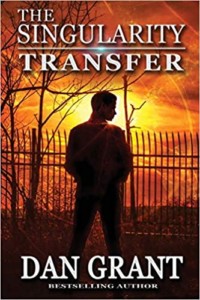Title: The Singularity Transfer
Author: Dan Grant
Publisher: MindScape Press, Inc.
ISBN: 978-1953764911
Pages: 544
Genre: Medical Thrillers/Medical Fiction/Techno-thrillers
Reviewed by: Tony Espinoza
Author Interview with Dan Grant
PBR: Tell us a little bit about yourself.
In high school, I worked as a draftsman at an engineering company. What I quickly learned is that I had a knack for drawing and engineering. Years later I went to college for engineering and found that I enjoyed storytelling too. At the time I read books from Crichton, Cook, Clancy, and Grisham. After my bachelor’s degree, I then got a dual master’s degrees in college teaching and English with an emphasis in creative writing. Once my engineering career got established, I returned to writing, focusing on thriller and suspense novels.
Engineering has provided content for stories. One example is during a state-of-the-art neurological surgical suite addition, I asked the cancer center’s neurosurgeon how the technology we were providing would make a difference to him. His response was magical, and the doctor could hardly stop talking about his work and how he sought to help his patients. This on-the-fly interview became the character sketch for Thomas Parker in both Singularity stories.
PBR: What was the inspiration behind your book, “The Singularity Transfer”?
Years ago, I was challenged by an editor at a publishing house to focus on a global story world, stories beyond my first two science/medical thrillers. I still remember that challenge and how I was able to sketch out future stories, while considering ways to keep each story fresh and original.
PBR: What themes or messages do you hope readers take away from you novel?
Since my present-time set stories integrate aspects of science, medicine, and technology trends, there’s always an underlying sense of moral quandaries and ethics. How do people and characters choose between two extremes? What arrivals of technology pose a greater risk than benefit, even if those basis of the discoveries foster a beneficial future for humankind?
PBR: One thing that really stands out in your book is the amount of detail you incorporated into the more scientific information you included in the narrative. How much research and time went into incorporating scientific fact with the science-fiction aspect of the novel, and what most fascinated you when doing this research?
The best storytellers find a balance between how much research is blended into the story and how much is left out. Michael Crichton, Tom Clancy, Robin Cook, Dan Brown, James Rollins, and Steve Berry have told or tell research-based stories. Each story is unique. Each set of characters are unique. As proven by these master storytellers, and many more not mentioned, the goal is to tell an entertaining story with something unique to say. Hopefully I’ve done that.
I want to make learning about science, medicine, technology both entertaining and interesting. Telling stories is a great way to do that. About half of the writing time is spent on research, reading, and exploring ideas.
Most of my research I find interesting. I love learning new things, about people and places. One such location was The Mansion on O Street in Washington, DC. Once I read about it I knew I had to find a way to pull that location into The Singularity Transfer. I visit and walk most of the places I write about.
PBR: If you could sit down and speak with any of the characters you crafted for this series, who would you speak to and what would you ask them?
While I enjoy the main heroes Thomas Parker and Kate Morgan, I enjoy the villains in both the Singularity and the Thirteen series. Villains are the heroes in their stories; they are richer and deeper than mere painted images, essences beyond darkness and evil. I would ask each of my villains about their futures, what happens after they win, and ask about what their grander world looks like, a place and time of their making.
PBR: When mapping out a series such as this one in which there are several viewpoints and complex, detailed storytelling, what do you focus on more: plot or character development and why?
Plot is essential. As a storyteller and I use a modified version of the hero’s journey model. Plot is the roadmap that a story takes, but ultimately it’s the characters and conflicts that they face that readers care about the most. In most cases, we’re interested in and want to see how characters get through their moments of crisis and conflict. Again, in most cases, if we relate to the hero character then we find ourselves cheering for that story person to succeed. As readers, we invest ourselves in the stories as well as the characters in them.
PBR: What would be your biggest piece of advice for upcoming or aspiring authors/writers who want to craft a comprehensive sci-fi and medical thriller book?
Here are a few bits of advice. Find a genre that fits you and your voice. Read, read, and read (books in your genre, books on craft and storytelling). Know what’s expected in your genre. Write what you love. Work hard at your storytelling craft. Work hard at being a good writer. And finally, strive to tell a good story.
PBR: Now that you have published your book, what are your future plans? Any other novels in the works?
In addition to having a lot of items electronically book marked, I have drawer full of concepts, research, and ideas. I probably have more story notes than I have time to tell stories. In addition to a couple of side projects, the Singularity series will continue for Thomas Parker and have at least two more books. Kate Morgan will return in her Thirteen series. Kate’s next thriller is called Thirteen Markers.



Follow Us